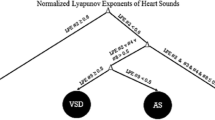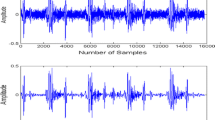Abstract
The objective of this study was to develop an automatic signal analysis system for heart sound diagnosis. This should support the general practitioner in discovering aortic valve stenoses at an early stage to avoid or decrease the number of surgical interventions. The applied analysis method is based on classification of heart sound signals utilising parameter extraction. From the wavelet decomposition of a representative heart cycle as well as from the Short Time Fourier Transform (STFT) and the Wavelet Transform (WT) spectra new time series were derived. In several segments, parameters were extracted and analysed. In addition, features of the Fast Fourier Transform (FFT) of the raw signal were examined. In this study, 206 patients were enrolled, 159 with no heart valve disease or any other heart valve disease but aortic valve stenosis and 47 suffering from aortic valve stenosis in a mild, moderate or severe stage. To separate the groups, a linear discriminant function analysis was applied leading to a reduced parameter set. The introduced two classification stage (CS) system for automatic detection of aortic valve stenoses achieves a high sensitivity of 100% for moderate and severe aortic valve stenosis and a sensitivity of 75% for mild aortic valve stenosis. A specificity of 93.7% for patients without aortic valve stenosis is provided. The developed method is robust, cost effective and easy to use, and could, therefore, be a suitable method to diagnose aortic valve stenosis by general practitioners.
Similar content being viewed by others
References
Bulgrin, J. R., B. J. Rubal, C. R. Thompson, and J. M. Moody. Comparison of short-time Fourier, wavelet and time-domain analyses of intercardiac sounds. Biomed. Sci. Instrum. 29:465–472, 1993.
Barker, L. F. Electrocardiography and phonocardiography: A collective review. Bull. Johns Hopkins Hosp. 21:358–389, 1910.
Bonferroni, C. E. Il calcolo delle assicurazioni su gruppi di teste. In: Studi in Onore del Professore Salvatore Ortu Carboni. Rome: Italy, 1935, pp. 13–60.
Bonferroni, C. E. Teoria statistica delle classi e calcolo delle probabilità. Pubblicazioni del R Istituto Superiore di Scienze Economiche e Commerciali di Firenze 8:3–62, 1936.
Cathers, I. Neural network assisted cardiac auscultation. Artif. Intell. Med. 7:53–66, 1995.
Dimond, E. G., and A. Benchimoi. Phonocardiography in pulmonary stenosis: Special correlation between hemodynamic and phonocardiographic findings. Ann. Intern. Med. 52:145–153, 1960.
Durand, L.-G., and P. Pibarot. Digital signal processing of the phonocardiogram: Review of the most recent advancements. Crit. Rev. Biomed. Eng. 23:163–219, 1995.
Durand, L.-G., M. Blanchard, G. Cloutier, H. Sabbah, and P. D. Stein. Comparison of pattern recognition methods for computer-assisted classification of spectra of heart sounds in patients with a porcine bioprosthetic valve implanted in the mitral position. IEEE Trans. Biomed. Eng. 37(12):1121–1129, 1990.
Durand, L.-G., Z. Guo, H. N. Sabbah, and P. D. Stein. Comparison of spectral techniques for computer assisted classification of spectra of heart sounds in patients with a porcine bioprosthetic valve. Med. Biol. Eng. Comput. 31(3):229–236, 1993.
Einthoven, W. The registration of human heart sound using the string galvanometer. Arch. Ges. Physiol. 117:461–478, 1907.
Guo, Z., L.-G. Durand, H. C. Lee, L. Allard, M. C. Grenier, and P. D. Stein. Artificial neural networks in computer-assisted classification of heart sounds in patients with porcine bioprosthetic valves. Med. Biol. Eng. Comput. 32(3):311–316, 1994.
Hadjileontiadis, L. J., and S. M. Panas. A wavelet-based reduction of heart sound noise from lung sounds. Int. J. Med. Inf. 52:183–190, 1998.
Harris, F. J. On the use of windows for harmonic analysis with the discrete Fourier transform. Proc. IEEE 66(1):51–83, 1978.
Holldack, K., and K. Gahl. Auscultation and percussion, inspection and palpation (in German: Auskultation und Perkussion, Inspektion und Palpation). Stuttgart, Germany: Georg Thieme Verlag, 1991.
Holldack, K., and H.-W. Rautenberg. Phonocardiography (in German: Phonokardiographie). Stuttgart, Germany: Georg Thieme Verlag, 1979.
Huiying, L., S. Lukkarinen, and I. Hartimo. Heart sound segmentation algorithm based on heart sound envelogram. Comput. Cardiol. 7–10, 1997.
Jamous, G., L.-G. Durand, Y. E. Langlois, T. Lanthier, P. Pibarot, and S. Carioto. Optimal time-window duration for computing time-frequency representations of normal phonocardiograms in dogs. Med. Biol. Eng. Comput. 30(5):503–508, 1992.
Kim, D., and M. E. Tavel. Assessment of severity of aortic stenosis through time-frequency analysis of murmur. Chest 124(5):1638–1644, 2003.
Lukkarinen, S., K. Sikioe, A.-L. Noponen, A. Angerla, and R. Sepponen (eds.). Novel Software for Real Time Processing of Phonocardiographic Signal. Chicago, USA: Applied Electronics Laboratory, Helsinki University of Technology, 1997.
Maass, H., and A. Weber. Recording of heart sounds using distinguishing filters, a study for standardization of the heart sounds (in German: Herzschallregistrierung mittels differenzierender Filter, eine Studie zur Herzschallnormung). Cardiologica 21:773, 1952.
Mallat, S. G. A theory for multiresolution signal decomposition. IEEE Trans. Pattern Anal. Machine Intell. 11(7):674–693, 1989.
Mardia, K. V., J. T. Kent, and J. M. Bibby. Multivariate Analysis (Probability and Mathematical Statistics). London: Academic Press, 1980.
Messer, S., J. Agzarian, and D. Abbott. Optimal wavelet denoising for phonocardiograms. Microelectron. J. 32:931–941, 2001.
Pavlopoulos, S. A., A. C. Stasis, and E. N. Loukis. A decision tree–based method for the differential diagnosis of Aortic Stenosis from Mitral Regurgitation using heart sounds. Biomed. Eng. Online 3:21, 2004.
Rangayyan, R. M., and R. J. Lehner. Phonocardiogram signal analysis: A review. Crit. Rev. Biomed. Eng. 15(3):211–236, 1987.
Author information
Authors and Affiliations
Corresponding author
Rights and permissions
About this article
Cite this article
Voss, A., Mix, A. & Hübner, T. Diagnosing Aortic Valve Stenosis by Parameter Extraction of Heart Sound Signals. Ann Biomed Eng 33, 1167–1174 (2005). https://doi.org/10.1007/s10439-005-5347-x
Received:
Accepted:
Issue Date:
DOI: https://doi.org/10.1007/s10439-005-5347-x




